

Thermoplastic Elastomer, as the name suggests is a combination of both, thermoplastics and elastomers. TPEs are a mix of plastics and rubber (elastomers) thus, they exhibit a combination of physical properties. For example, TPEs combine the flexibility of the rubber with the toughness of the thermoplastics.
TPE can be customized in order to reflect the properties required for the project. For instance, if a company requires to manufacture a particular type of plastic casing that exhibits toughness, and high wear resistance with a certain amount of elasticity then, TPE can be customized to meet these specific properties. It is thus, one of the most versatile injection molding materials. In this article, we describe TPE properties, their types, applications, and how they can be customized.
A thermoplastic elastomer, abbreviated for TPE, is a type of polymer material with the physical and chemical characteristics of elastomers and thermoplastics. TPEs exhibit high elasticity of thermoset rubber at room temperature and they demonstrate excellent processability of thermoplastics at slightly elevated temperatures (150–210℃ / 302–410℉).
TPEs are basically polymers that exhibit thermoplastic characteristics above their melt temperatures. This property enables them to be shaped while possessing elastomeric behavior without cross-linking during fabrication. This process is also reversible which means that the product can be reprocessed and remolded.
TPEs are popular because it’s easy to achieve outstanding properties by simply varying the blend compositions, the viscosity of the components, and compounding ingredients.
A typical TPE must fulfill the following characteristics:
All TPEs include crystalline and amorphous segments. These can be either physical blends or a chemical mixture of crystalline and amorphous domains in the polymer chain of the block copolymers.
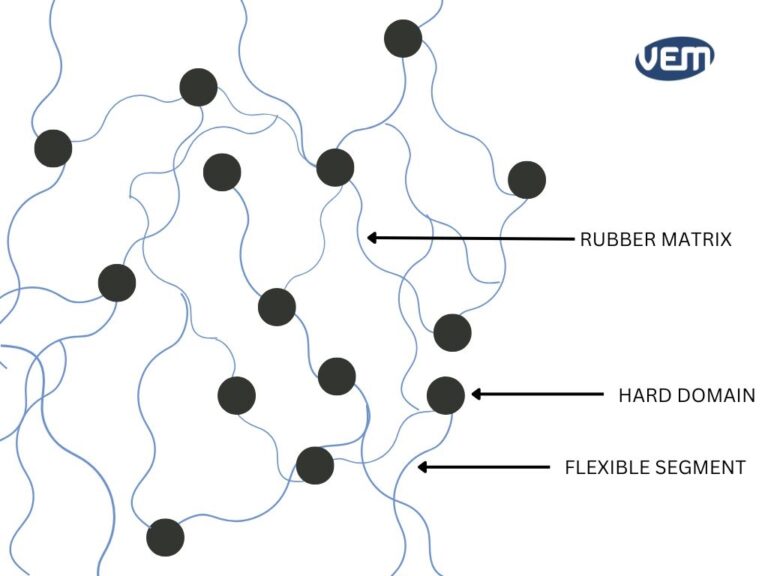
The hard blocks are responsible for easy processing, temperature resistance, adhesion, and material properties such as tear and tensile strength or chemical resistance. The soft blocks are responsible for the elastic properties. They also determine the hardness and flexibility of the material.
TPEs are divided into two distinct categories: Blend and block copolymers.
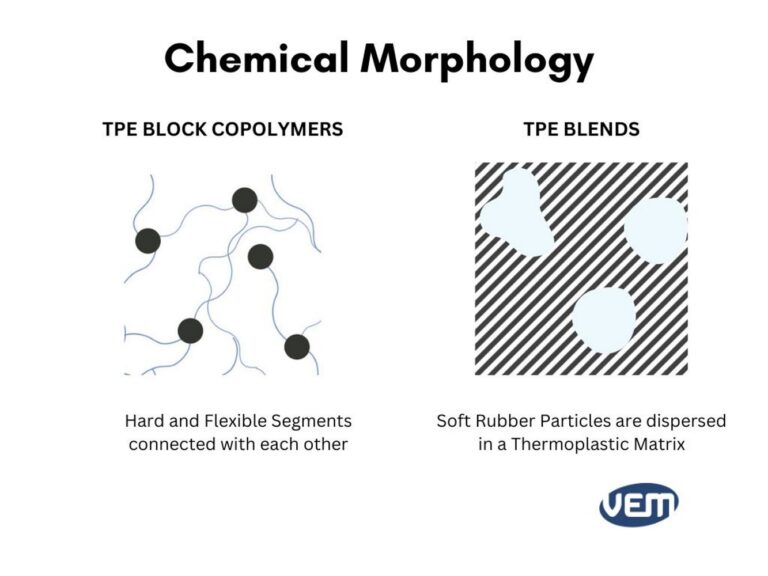
This distinction is based on the structural composition. Let’s understand these types, more in detail:
You must note that the polymer system of TPEs has both crystalline and amorphous domains. Blend Copolymer TPEs are achieved by a mechanical mixture of semi-crystalline and amorphous polymers.
Block copolymer TPEs are based on polymers that have hard and soft blocks along the backbone of the polymer chain. The crystalline domains that are formed into hard blocks during the melt give the characteristic thermoplastic behavior whereas the amorphous domains that form elastomeric bridges give an elastomeric behavior.
A polymer is a large molecule made of repeating chemical units. They are classified according to their formation ability.
Thermoplastic elastomers belong to the synthetic elastomer class. The following diagram depicts its position in the polymeric group:
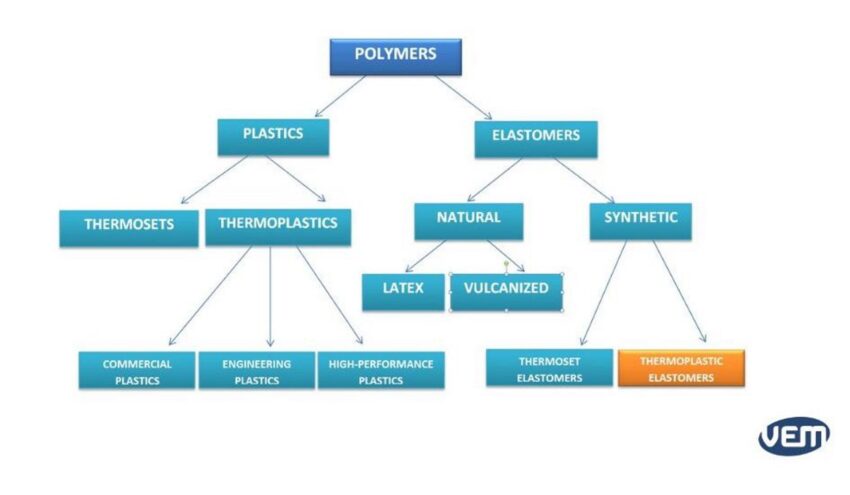
SBCs are multi-phase compounds in which the phases are chemically bonded through block polymerization. SBCs are in a poly (styrene-b-elastomer-b-styrene) structure.
Styrenics are most commonly used among the basic TPE categories because styrenic block copolymers can successfully blend with many materials including fillers, extenders, additives, and other resins.
The soft phase in SEBS is ethylene butylene, which is produced by hydrogenating SBS. Due to the lack of double bonds in their structures, they have very good heat, UV, oil, and chemical resistance.
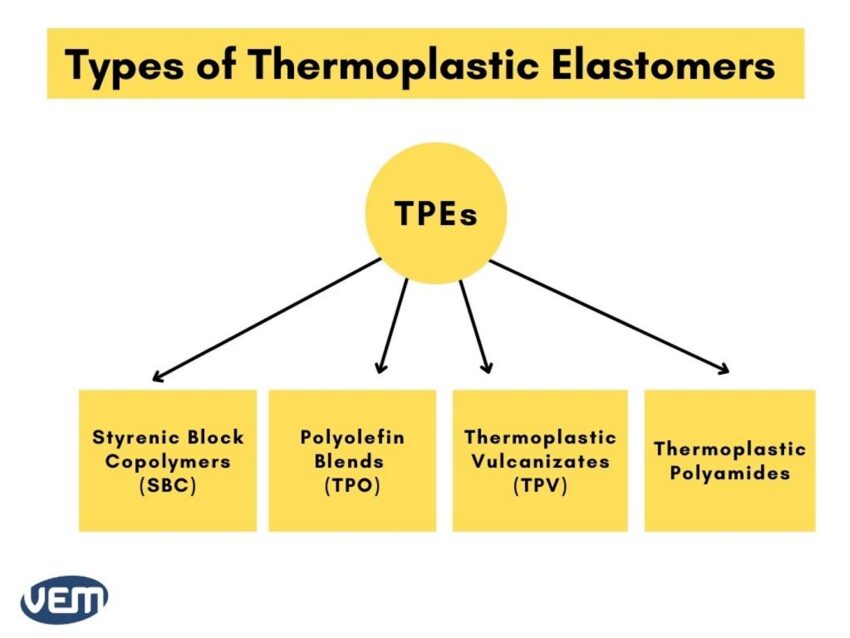
Thermoplastic vulcanizates are formed through the homogeneous dispersion of crosslinked rubber parts in the thermoplastic phase through dynamic vulcanization.
In this case, two polymer phases (elastomer and plastic) are required for dynamic vulcanization. Dynamic vulcanization is a process of crosslinking a polymer while mixing another polymer in the molten state.
Most commercial TPVs are based on a mixture of Ethylene Propylene Diene Monomer (EPDM) and Polypropylene (PP). PP is used because it has a high melting point and crystallinity, therefore it imparts good properties at high temperatures. EPDM is used because it has a high temperature, oxygen, and ozone stability and thus, it enables the production of TPVs with good heat oxidation and ozone resistance.
Thermoplastic polyolefins are obtained by mixing uncrosslinked amorphous rubbers and semi-crystalline polyolefin thermoplastics in a molten state. The production processes of TPO do not include a vulcanization step. TPOs are impact and chemical-resistant.
It is imperative to understand the type of elastomer that is right for your project! A weak elastomer could damage the product or cause safety hazards whereas an excessively strong rubber could render the products extra rigid to fit the requirements of your project.
You should consider factors such as the project’s temperature range, the substance resistance of the material, and the industry it needs to be applied to. It is recommended to choose an elastomer that will be compliant with your chosen industry.
There are prominent differences between Natural rubber and TPE. Natural rubber exhibits great resilience and excellent elastic properties. They however have poor chemical resistance and are not so great in terms of processability. TPE, on the other hand, is extremely brittle but is great when it comes to processability.
Let’s understand more about the similarities and differences between Natural rubber and TPE:
Natural rubber is an organic compound and a type of elastomer. It is an isoprene polymer that is derived from natural sources such as Hevea brasiliensis, rubber fig, and Pará rubber trees. These trees contain a milky, sap-like substance that is collected by making incisions in the bark of the trees. This substance is known as Latex and is processed for various applications.
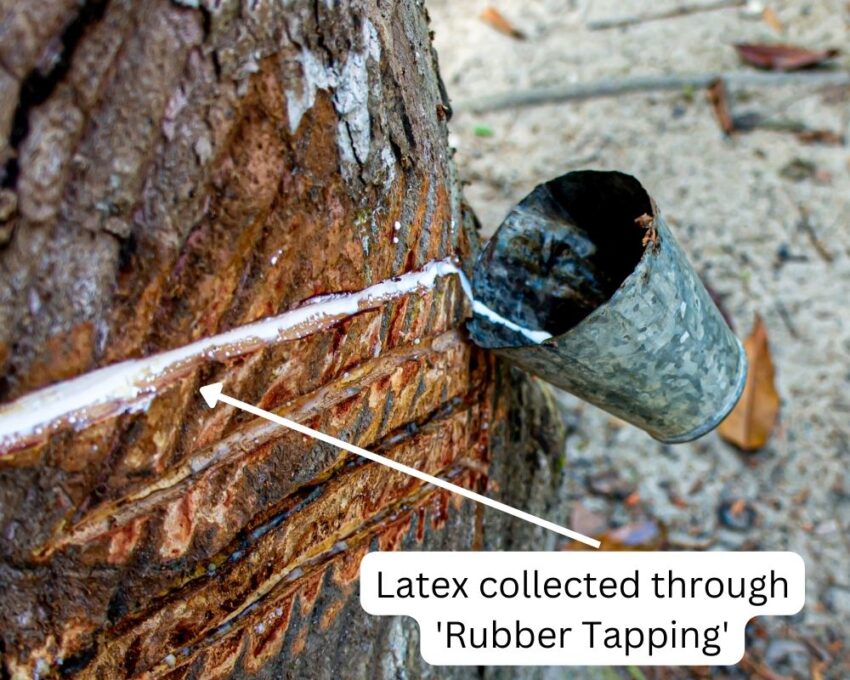
Now, do we understand what Natural rubber is? Let’s understand how it is different from synthetic elastomers. Natural rubber consists of isoprene monomers that are loosely held together. They can be pulled apart and altered but they have the ability to always revert back to their original shape. This property gives rubber its primary property of natural flexibility and elasticity. Synthetic elastomers, on the other hand, have long, randomized polymer chains that when pulled apart do not always revert back to the same shape.
Natural rubber is softer than synthetic elastomers, making it an ideal choice for manufacturing anti-vibration components, springs, automotive parts, shoe soles, and medical tubing. Natural rubber is also strong and heat resistant which is why it is used very popularly to manufacture high-performance tires.
Natural rubber offers various benefits. It makes an optimal choice for various applications due to the following reasons:
Though natural rubber has various advantages, it may not always be the best fit for every application. Like every plastic or injection molding material has disadvantages, natural rubber also has limitations. Let’s take a look at its disadvantages:
TPEs, when heated flow freely, and when cooled almost regain their original structure but not as well as Natural rubber.
Natural Rubber exhibits physical properties such as excellent tensile, elongation, and, tear resistance. Additionally, it exhibits good abrasion resistance but poor resistance to ozone, oxygen, sunlight, and heat. TPE, on the other hand, exhibits great resistance to sunlight, and heat and is UV-resistant.
It also exhibits excellent low-temperature flexibility. The temperature range for Natural rubber is -55° C to +82° C / -67° F to +180° F whereas TPE is 150–210℃ / 302–410℉.
Let’s take a look at some of its pros and cons in comparison to Natural rubber.
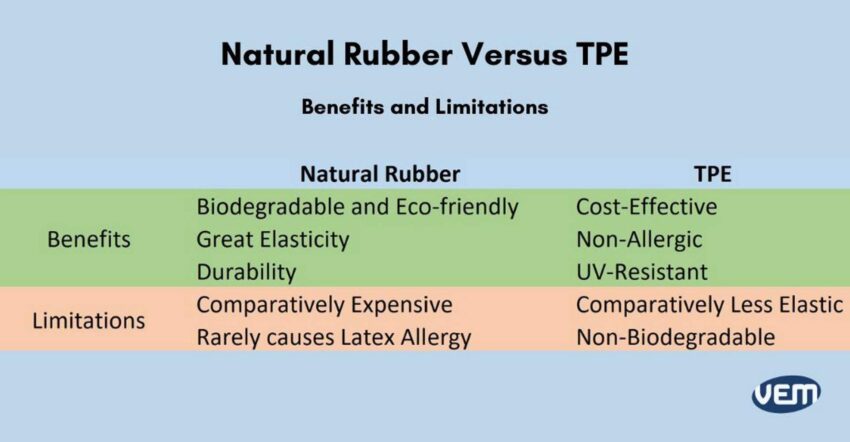
Additionally, there are some more TPE properties to consider. We have listed these below:
The principal difference between thermoset and thermoplastic elastomers is due to crosslinking bonds in their structures. Crosslinking is a structural component that is critical for imparting polymers with highly elastic properties.
TPEs and Thermosets are both polymers, but they behave differently when exposed to heat. At high temperatures, thermoplastics can melt under heat after curing while thermosets can retain their form. Thermosets, unlike TPEs, stay solid once cured.
Thermoplastics have a low melting point, and they are thus ideal for applications that use recycled materials. Thermosets, on the other hand, are able to withstand high temperatures without losing their shape, making them more durable and suitable for high-temperature application projects.
TPR is interchangeably referred to as TPE since they both exhibit rubber-like appearance but they are different polymers and extremely distinct in their characteristics from each other.
As described earlier, TPE is abbreviated for Thermoplastic Elastomer. Elastomers are commonly referred to as rubber thus, they are often regarded as the same types of polymers. However, they are both modified versions of different materials. TPR is synthesized using block copolymers such as Styrene-Butadiene-Styrene (SBS) polymer whereas TPEs are manufactured using Styrene-Ethylene-Butadiene-Styrene (SEBS) polymer. SEBS has a molecular formula in a saturated state, and its aging, yellowing, high-temperature, and corrosion resistance are better than SBS. Thus, they both exhibit different properties and cannot be regarded as the same.
You should note that TPE and TPR both have the ductility of plastic and vulcanized rubber, but TPR has an unsaturated fatty molecular formula (similar to vulcanized rubber), thus, it has the tactile sensation and resilience of vulcanized rubber.
Let’s take a look at some more similarities and differences between Thermoplastic elastomers and Thermoplastic rubber:
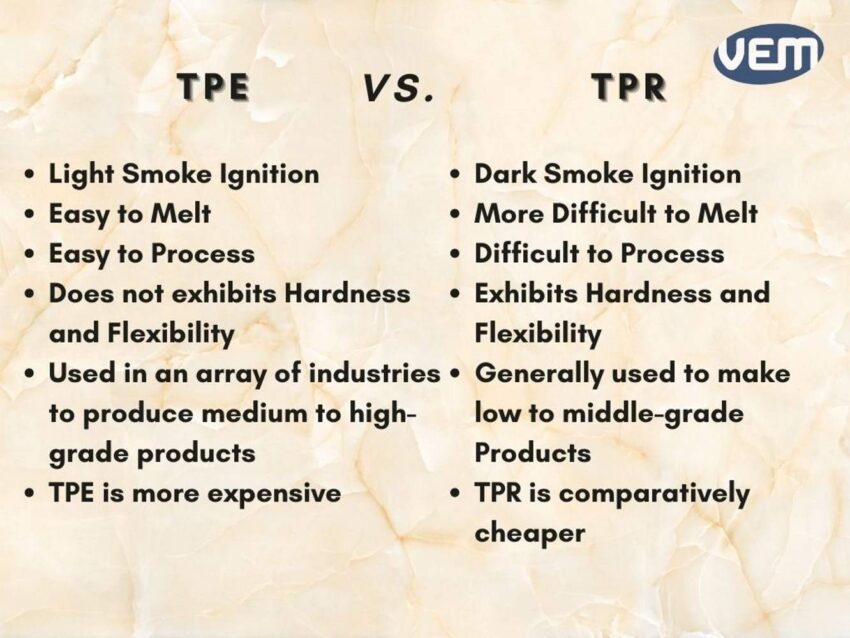
You can read about TPR materials in-depth here.
One of the most critical stages in any manufacturing process is ‘material selection’. It determines the development of the final plastic part. There is a wide range of TPEs available, and we have listed below, a TPE material checklist to help you simplify the process. Let’s take a look at some of the most common factors that you should consider for TPE material:
It is imperative to understand the application requirements in order to achieve the product requirements. The manufacturer should not only understand the extent of the application requirements but also whether it’s an existing or a novice application. If it’s a new application, you might need a new TPE grade, and if it’s an existing application, the same TPE can be used.
Additionally, the following factors should be considered:
TPEs can be formulated from the standard variations to meet a specific requirement. TPEs are popular injection molding materials because they can be customized to include a specific physical or chemical property to fit the product design and requirements. Today, there are various TPE formulations available. We have listed some of the most important material requirements to help you evaluate your application. These requirements are listed below:
TPEs are versatile and they exhibit excellent chemical resistance. They also demonstrate exceptional thermal properties and material stability.
It is also essential to understand the industry type as that will influence various requirements. For instance:
It is important to understand what the production costs are. There are various types of TPEs available and with that, the resin prices vary. It is thus essential to factor in the production costs.
Thermoplastic elastomers have unique properties that have made them a popular injection molding material. They are today, applied to manufacture a wide range of products in various industries. Let’s take a look at some of its popular applications:
TPE is widely used for automotive applications due to its flexibility, excellent wear, chemical, and electrical resistance, and UV stability. Examples of its application in the automotive industry include weather seals, bumpers, exterior & interior parts, instrument panels, air ducts, pipe grommets, glass encapsulation, drive belts, high/low-pressure pipes, and mats for motor scooters.

TPE is flexible, biocompatible, lightweight, and chemically resilient. This makes it useful for breathing tubes, syringe seals, masks, and catheters.
Due to its electrical resistance and ability to be molded, TPE is very popularly used in the electronics industry to manufacture mobile phone components, sheaths for condensers, plugs and loose sockets, and cables.
Its durability and flexibility make it the perfect choice for extruded weather seals for doors and windows, glazing, and pipe seals.
Due to its flexibility, wear resistance, and UV stability, TPE is applied to manufacture items for diving (flippers, snorkels, masks) and skiing (ski pole handles, ski boots).
TPE exhibits durability, flexibility, ease of molding, and chemical resistance which are desirable properties for manufacturing various consumer goods such as remote control covers and mobile phone cases. TPEs are also applied to manufacture magnetic seals for refrigerators, push-button panels, and shock-absorbing protections for vacuum cleaners.

Thermoplastic elastomers have unique properties as they combine thermoplastics with rubbers. TPE technologies can also be further customized to offer a wide range of mechanical properties that are diverse. It is thus applied to various applications.
VEM Tooling has the expertise for your TPE injection molding project. To better understand how VEM tooling can provide you with the expertise and serve you for your TPE injection molding project, contact us or request a quote today.
TPEs are manufactured by combining a hard and soft material that typically forms its crystalline and amorphous domains.
TPEs are non-allergic and they are considered to be safe. Various grades of TPEs are often used in the medical and food industry. Some TPEs are also categorized in FDA’s GRAS (Generally Recognized as Safe) category.
Yes, TPEs are water-proof. They can also be blended with additives to make them extremely waterproof which is why they are often applied in water-proof electronic applications.
TPEs are naturally white or cream in color which is why they can be easily colored. There is no limitation when we talk about dyeing TPEs.
TPEs are naturally white or cream in color which is why they can be easily colored. There is no limitation when we talk about dyeing TPEs.
TPEs are naturally white or cream in color which is why they can be easily colored. There is no limitation when we talk about dyeing TPEs.